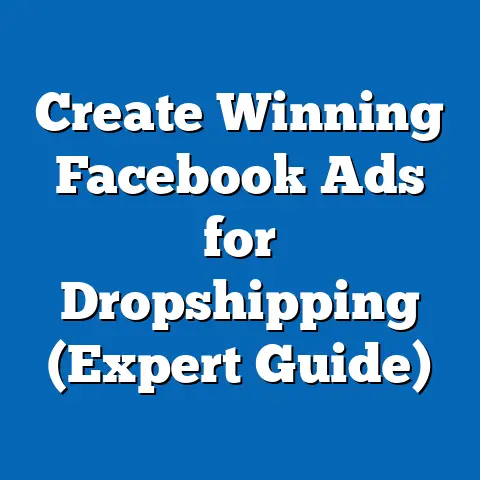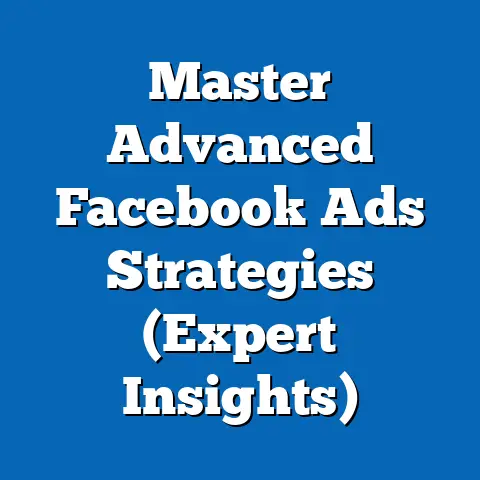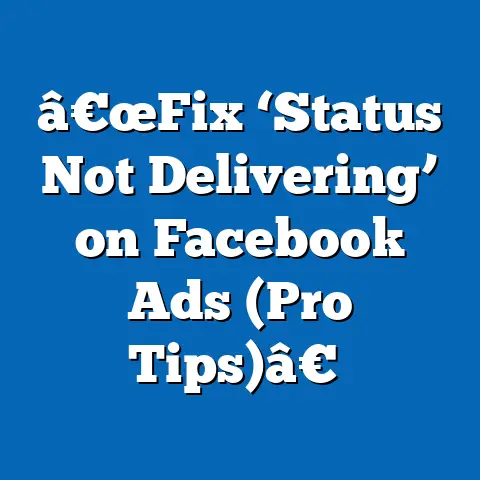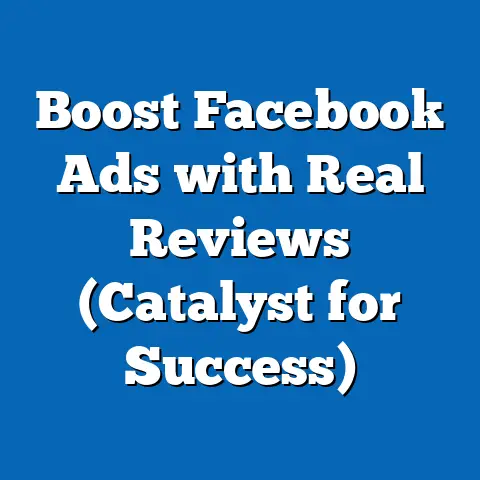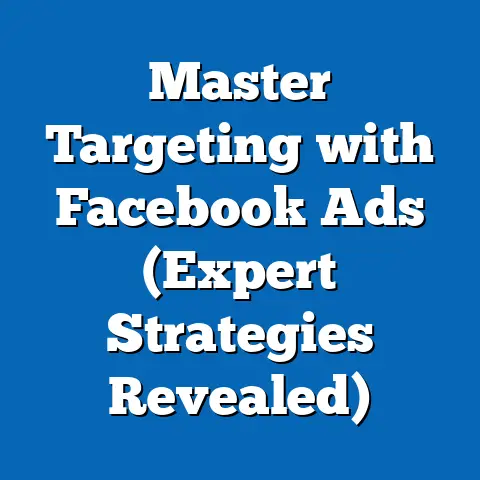Transforming Video for Facebook Ads (Pro Techniques Revealed)
Imagine a lifestyle upgrade where your small business or personal brand skyrockets to new heights, connecting with millions of potential customers through the power of video on social media. Video content on platforms like Facebook has become a game-changer for advertisers, with 84% of marketers reporting that video is an effective tool for generating leads, according to a 2022 survey by Wyzowl. As of 2023, Facebook remains a dominant platform for video advertising, with over 2.9 billion monthly active users, making it a critical space for businesses aiming to capture diverse demographics.
This article dives deep into the professional techniques for transforming video content into high-performing Facebook ads. We’ll explore key statistical trends, such as the 66% increase in video ad spending on social media from 2017 to 2022, as reported by eMarketer. Additionally, we’ll break down demographic engagement data, compare historical video ad performance with current metrics, and project future trends based on emerging technologies and consumer behaviors.
The Rise of Video in Digital Advertising: A Statistical Snapshot
Video content has redefined the digital advertising landscape, and Facebook stands at the forefront of this revolution. According to Statista, video ads on social media platforms accounted for $24.6 billion in global ad spend in 2022, with projections estimating a rise to $37.4 billion by 2025. On Facebook specifically, video content drives 8 billion daily video views, a figure that underscores the platform’s unparalleled reach, as reported by Meta in 2023.
Why has video become so dominant? A 2022 study by HubSpot revealed that 54% of consumers prefer video content over other formats when learning about products or services. This preference is even more pronounced on mobile devices, where 75% of video consumption occurs, aligning with Facebook’s mobile-first user base of 98.5% of its active users accessing the platform via smartphones (Hootsuite, 2023).
Engagement metrics further highlight video’s impact. Posts with video content on Facebook generate 59% more engagement than non-video posts, according to a 2021 analysis by Socialbakers. These statistics paint a clear picture: mastering video for Facebook ads isn’t just an option—it’s a necessity for brands seeking a competitive edge.
Demographic Breakdown: Who’s Watching Video Ads on Facebook?
Understanding the demographics of Facebook’s video audience is critical for tailoring content that resonates. As of 2023, Facebook’s user base spans a wide age range, with 25-34-year-olds making up the largest segment at 31.5% of users, followed by 18-24-year-olds at 23.8%, per Statista data. However, older demographics are growing rapidly, with users aged 45-54 increasing by 12% year-over-year, reflecting the platform’s broadening appeal.
Gender distribution on Facebook is nearly balanced, with 56.3% male users and 43.7% female users globally (Hootsuite, 2023). Yet, engagement with video ads shows nuanced differences: women aged 25-34 are 18% more likely to click on video ads for lifestyle and beauty products, while men in the same age group show a 22% higher engagement with tech and gaming content, according to a 2022 Meta Insights report.
Geographically, video ad performance varies significantly. In North America, video ads achieve a click-through rate (CTR) of 1.2%, compared to 0.8% in Europe and 1.5% in Asia-Pacific regions, as per eMarketer’s 2023 analysis. These disparities highlight the importance of localized content strategies, especially for multinational campaigns.
Income levels also play a role in video ad engagement. Users in higher income brackets (above $75,000 annually) are 15% more likely to complete video ad views, likely due to greater purchasing power and interest in premium products, per a 2021 Nielsen study. Conversely, younger users in lower income brackets (under $30,000) show higher initial engagement but lower conversion rates, emphasizing the need for budget-friendly calls-to-action.
Historical Trends: How Video Ads on Facebook Have Evolved
To appreciate the current state of video ads on Facebook, it’s essential to look back at their evolution. When Facebook first introduced video ads in 2013, they were a novelty, with limited autoplay functionality and rudimentary targeting options. Early data from 2014 shows that video ads had an average CTR of just 0.9%, a figure constrained by slower internet speeds and less sophisticated mobile devices, as reported by AdAge.
By 2017, the landscape had shifted dramatically. The introduction of in-stream video ads and improved autoplay features led to a 25% surge in video ad impressions year-over-year, according to eMarketer. Engagement metrics also improved, with CTRs rising to 1.1% as advertisers began experimenting with shorter, punchier content to capture attention within the first 3 seconds.
Fast forward to 2020, and the COVID-19 pandemic accelerated video consumption on social media. With lockdowns driving a 40% increase in time spent on Facebook, video ad views spiked, and completion rates for 15-second ads rose by 18%, per Meta’s 2020 annual report. This period also marked the rise of vertical video formats, aligning with mobile-first consumption trends.
Comparing historical data to 2023, the average CTR for video ads has stabilized at around 1.3%, but cost-per-click (CPC) has risen by 30% since 2017 due to increased competition, as noted in a 2023 report by Socialbakers. Moreover, the shift toward Stories and Reels—short-form video formats—has redefined creative strategies, with 62% of advertisers now prioritizing vertical content over traditional horizontal formats (Hootsuite, 2023).
Pro Techniques for Transforming Video for Facebook Ads
1. Craft Thumb-Stopping Visuals in the First 3 Seconds
Attention spans on social media are notoriously short, with Meta reporting that 65% of users decide whether to watch a video within the first 3 seconds. To combat this, leading advertisers use bold visuals, vibrant colors, and text overlays to hook viewers instantly. A 2022 study by VidMob found that videos with text in the opening frame see a 12% higher engagement rate.
Consider starting with a striking image or a question that piques curiosity. For example, a fitness brand might open with “Want to lose 10 pounds in 30 days?” paired with dynamic workout footage. Ensure your branding or logo appears early to build recognition, as 70% of users associate branded content with trust, per a Nielsen report.
2. Optimize for Silent Viewing with Captions
A staggering 85% of Facebook videos are watched on mute, according to a 2021 Digiday study, largely due to users browsing in public spaces or during downtime. Adding captions isn’t just a nice-to-have—it’s essential. Videos with captions see a 16% increase in watch time and a 10% higher CTR, as reported by Meta Insights in 2022.
Use clear, concise subtitles that convey your core message without overwhelming the viewer. Tools like Facebook’s automatic captioning or third-party platforms like Rev can streamline this process. Additionally, incorporate visual cues like animated text or emojis to maintain engagement even without sound.
3. Leverage Vertical and Short-Form Video Formats
With the rise of Stories and Reels, vertical video (9:16 aspect ratio) has become the gold standard for mobile-first platforms like Facebook. A 2023 report by Hootsuite found that vertical videos achieve 35% higher completion rates compared to horizontal formats. Moreover, short-form content under 15 seconds drives 20% more clicks, aligning with users’ preference for quick, digestible content.
Test different lengths to find what resonates with your audience, but aim to keep core messaging concise. For instance, a fashion brand might showcase a quick outfit transition in a 10-second Reel, paired with a “Shop Now” CTA. Use Facebook’s analytics to track performance and refine your approach.
4. Hyper-Target Your Audience with Advanced Segmentation
Facebook’s ad platform offers unparalleled targeting options, from demographics to interests to behaviors. A 2022 eMarketer study revealed that hyper-targeted video ads achieve a 22% higher conversion rate compared to broadly targeted campaigns. Use lookalike audiences to reach users similar to your best customers, or retarget viewers who’ve engaged with previous content.
Layering interests with demographics can yield powerful results. For example, a pet supply brand might target dog owners aged 25-44 with interests in outdoor activities, achieving a 30% lower cost-per-acquisition, per a Meta case study from 2021. Regularly analyze audience insights to adjust targeting parameters for optimal ROI.
5. Test and Iterate with A/B Testing
No single video ad formula guarantees success, which is why testing is crucial. A 2023 report by Socialbakers found that advertisers who run A/B tests on video content see a 15% uplift in engagement metrics. Experiment with variables like video length, CTA placement, and thumbnail imagery to identify what drives results.
Use Facebook’s split testing feature to compare two versions of an ad with identical budgets. Track metrics like CTR, cost-per-view, and conversion rate to determine the winning variant. Continuous iteration based on data ensures your video ads remain relevant and effective.
Contextual Factors Driving Video Ad Success on Facebook
Several external factors influence the effectiveness of video ads on Facebook, beyond creative and targeting strategies. First, platform algorithms prioritize content that drives engagement, meaning videos that spark comments, shares, and reactions are more likely to appear in users’ feeds. A 2022 Meta update confirmed that videos prompting interaction receive a 25% boost in organic reach.
Second, economic conditions impact ad performance. During economic downturns, such as the 2020 recession, users were 18% more likely to engage with value-driven video ads (e.g., discounts or free trials), per a Nielsen study. Conversely, in periods of growth, premium product ads see higher conversion rates as disposable income rises.
Third, technological advancements shape video consumption. The rollout of 5G networks has reduced buffering times, leading to a 14% increase in video watch time since 2021, according to Statista. Additionally, the growing adoption of augmented reality (AR) in ads—supported by Meta’s Spark AR platform—has boosted engagement by 19%, offering interactive experiences like virtual try-ons.
Finally, cultural trends play a role. The rise of sustainability awareness has led 60% of Gen Z users to favor brands with eco-friendly messaging in video ads, per a 2023 HubSpot survey. Tailoring content to align with such values can enhance brand affinity and drive long-term loyalty.
Future Projections: The Next Frontier for Video Ads on Facebook
Looking ahead, video advertising on Facebook is poised for continued growth and innovation. eMarketer projects that global social media video ad spend will reach $50 billion by 2027, with Facebook maintaining a significant share due to its massive user base and advanced ad tools. Short-form video, particularly Reels, is expected to account for 40% of video ad impressions by 2025, reflecting TikTok-inspired consumption patterns.
Artificial intelligence (AI) will play a pivotal role in shaping video ad strategies. Meta’s investments in AI-driven content creation and ad optimization are expected to reduce production costs by 20% for small businesses by 2026, per a 2023 Forrester report. AI tools will also enhance personalization, delivering tailored video content based on real-time user behavior.
Privacy regulations, such as the EU’s GDPR and Apple’s App Tracking Transparency (ATT) framework, will continue to challenge advertisers. A 2022 Statista survey found that 30% of users are less likely to share data post-ATT, potentially impacting targeting precision. However, Meta’s shift toward on-platform analytics and first-party data collection could mitigate these effects, ensuring sustained ad relevance.
Demographic shifts will also influence video ad strategies. As Gen Z becomes a dominant consumer group—projected to account for 27% of global income by 2030, per Bloomberg—brands will need to prioritize authenticity and interactivity in video content. Interactive formats like polls or shoppable videos are forecasted to drive a 25% increase in engagement among younger audiences by 2025, according to Hootsuite.
Finally, the integration of virtual reality (VR) and the metaverse presents untapped potential. Meta’s Horizon Worlds platform could enable immersive video ad experiences, with early tests showing a 30% higher recall rate for VR ads compared to traditional formats (Meta, 2023). While adoption remains niche, VR video ads could become mainstream by the end of the decade as hardware becomes more accessible.
Conclusion: Elevating Your Brand with Video on Facebook
Transforming video for Facebook ads is both an art and a science, requiring a deep understanding of audience behavior, creative optimization, and data-driven decision-making. The statistics are clear: with 84% of marketers relying on video for lead generation and 59% higher engagement for video posts, this medium is indispensable for modern advertising. By implementing pro techniques like thumb-stopping visuals, silent-viewing optimization, and hyper-targeting, brands can unlock the full potential of Facebook’s vast user base.
Historical trends show how far video ads have come—from a 0.9% CTR in 2014 to a robust 1.3% in 2023—while demographic data underscores the need for tailored content across age, gender, and geographic lines. Contextual factors, from algorithm updates to cultural shifts, further shape success, demanding adaptability from advertisers.
Looking forward, the future of video ads on Facebook is bright, with innovations in AI, short-form content, and immersive technologies set to redefine engagement. As ad spend climbs toward $50 billion by 2027, staying ahead of trends will be key to maintaining a competitive edge. Whether you’re a small business owner or a global brand, mastering video on Facebook isn’t just a path to a lifestyle upgrade—it’s a strategic imperative for growth in the digital age.

